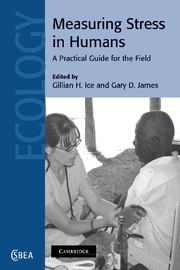Book contents
- Frontmatter
- Contents
- Contributors
- Foreword by Geoffrey A. Harrison
- Part I General principles
- Part II Measuring stress responses
- 2 Cultural dimensions of the stress process: measurement issues in fieldwork
- 3 Measuring emotional and behavioral response
- 4 Measuring hormonal variation in the sympathetic nervous system: catecholamines
- 5 Measuring hormonal variation in the hypothalamic pituitary adrenal (HPA) axis: cortisol
- 6 Measuring physiological changes in the cardiovascular system: ambulatory blood pressure
- 7 Measuring immune function: markers of cell-mediated immunity and inflammation in dried blood spots
- Part III Practical issues in studying stress
- Index
- References
4 - Measuring hormonal variation in the sympathetic nervous system: catecholamines
Published online by Cambridge University Press: 11 September 2009
- Frontmatter
- Contents
- Contributors
- Foreword by Geoffrey A. Harrison
- Part I General principles
- Part II Measuring stress responses
- 2 Cultural dimensions of the stress process: measurement issues in fieldwork
- 3 Measuring emotional and behavioral response
- 4 Measuring hormonal variation in the sympathetic nervous system: catecholamines
- 5 Measuring hormonal variation in the hypothalamic pituitary adrenal (HPA) axis: cortisol
- 6 Measuring physiological changes in the cardiovascular system: ambulatory blood pressure
- 7 Measuring immune function: markers of cell-mediated immunity and inflammation in dried blood spots
- Part III Practical issues in studying stress
- Index
- References
Summary
It is commonplace for people to conceptualize the body's response to stress as an “adrenaline rush,” with the symptoms of this response, as described by Cannon (1915), characterizing the “fight or flight” response. This common understanding of the stress response encompasses one major component of biological stress: activation of the sympathetic adrenal medullary system (SAMS). The other main arm of the stress response, the hypothalamic pituitary adrenal cortex (HPA) axis, will be discussed in the next chapter. Activation of the SAMS has widespread effects in the body. These effects are seen as being allostatic in nature; that is, they help maintain homeostasis through the initiation of physiological change. Measures of stress have been used that identify the indirect effects of SAMS activation such as increased pulse and blood pressure. Other measures, to be examined here, focus on more direct evidence for SAMS activation.
Stress has taken on great importance for humans in the modern world. The most common ailments that threaten us, such as cardiovascular disease, diabetes, and even some cancers, apparently are influenced by chronically high stress levels. The response that has allowed our ancestors to adapt to the stressors that were part of their world now appears too often to be an inappropriate one for the kinds of stressors, from traffic to deadlines, that confront us today (Sapolsky, 1994).
The stress response represents adaptation to actual or perceived challenges from the environment, with this process termed “allostasis” (McEwen, 1998).
- Type
- Chapter
- Information
- Measuring Stress in HumansA Practical Guide for the Field, pp. 94 - 121Publisher: Cambridge University PressPrint publication year: 2006
References
- 3
- Cited by

